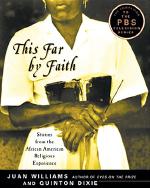Issue Date: May 23, 2003
Reviewed by DIANA HAYES Written as a companion text to the forthcoming PBS series of the same name, This Far By Faith presents vignettes of the African-American religious historical experience in an easy to read and fairly comprehensive form. It touches on a number of different but related issues such as African traditional religion, African retentions in the Americas (Africanisms), the origins and expressions of the “Invisible Institution,” slavery, and the spirituals as religious and revolutionary texts. It is especially good in its presentation of the role played by free blacks in the Abolition movement and the beginnings of the Holiness movement, which led to the emergence of black Pentecostalism. Other movements developed and led by African-Americans as a result of their faith, including the critical civil rights movement, are also well presented and discussed. The work thus shows the far-reaching impact of faith in diverse forms, not only on the lives of African-Americans but also on the lives of all Americans. Emphasis is placed on important figures in black religious history in the United States, such as Sojourner Truth, itinerant preacher and women’s rights advocate; Bishop Henry McNeal Turner, the first to proclaim God’s blackness; Richard Allen, the founder of the oldest African-American denomination, the African Methodist Episcopal Church; Richard Henry Boyd, founder of the National Baptist Publishing Board; Charles H. Mason, founder of the Church of God in Christ denomination, and many others in both full-length chapters and boxed summaries. Lacking for the most part, however, are the voices and stories of the many African-American women who were itinerant preachers, sought and were usually denied ordination, and worked for the betterment of the black community and the black church as women of faith. The authors clearly sought to be inclusive and there are boxed overviews of the black Jews and the Afro-Latino-Catholic religions, such as Santeria. There are full-length chapters on non-Christians such as Prince Ibrahima Abdul Rahman, a slave for 40 years who finally regained his freedom and returned to Africa (Liberia rather than the country of his birth), and the Black Muslim movement and the Moorish Science Temple movement; also on black Buddhists and Hindus, a fairly recent phenomenon. The book is clearly written for a popular audience and gives a broad perspective on varieties of the black religious experience. Much of the material presented is not new to those familiar with black religious history, but the authors’ efforts to pull from what must have been hundreds of sources to compile an eminently readable text is praiseworthy. I look forward to the documentary, which will, I hope, develop many of the points in greater detail. The work, however, is disappointing in two areas, minor and major. The minor issue is the lack of fuller references to the sources consulted rather than just the section of general sources. A number of quotes are used without full citation (especially publishers’ names), making it rather difficult for those who might like to explore this history in greater detail. A more serious lack, however, is the failure to provide the same in-depth discussion given to Protestant Christianity, Islam, and even blacks moving into Hinduism and Buddhism, to blacks in the Roman Catholic church. Their historical and religious experience is relegated to captions for two pictures and the role John Paul II played in the Polish Solidarity movement. The usual 1619 date for the first arrival of blacks to the American colonies is given, revealing a lack of knowledge, once again, of the black presence in the French and Spanish colonies dating to the early 1500s. Nor are any sources for the black Catholic religious experience cited, despite the fact that church historian Albert Raboteau is quoted in the text. The works of Fr. Cyprian Davis, Stephen Ochs, Charles McGreevy, Diane Batts Morrow and others are missing, yet would have been a welcome addition. From this book, one receives the impression that there are only a handful of black Catholics and that they had no role in the development of the black community in the United States or any participation in its history, rather than the 3 million plus that do exist, making them the third-largest group of black Christians in the United States. It is to be hoped that the June 24-26 PBS documentary will go into greater detail and be more representative of the breadth, depth and pluralistic history of African-American faith. Diana Hayes is an associate professor of theology at Georgetown University in Washington. National Catholic Reporter, May 23, 2003 |
